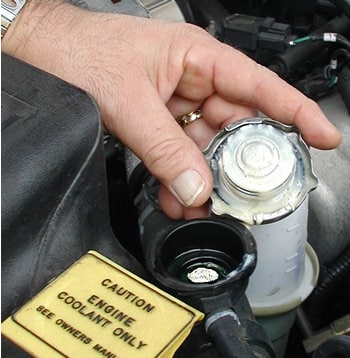How is hot water cooled in the radiator?
Radiators are by definition "convectors" or "heat exchangers." Radiators mostly involve liquids and changing the temperature of these liquids from hot to cold to hot and so forth. The goal of a car radiator is to draw heat away from the engine and replacing the environment with cooler water drawn from the radiator.
Radiators are located front of the engine and behind the front grill of the car. This puts the radiator in a position to receive relatively cold outside air. Radiators have fins sticking out from the pipes to increase the surface area where air can come into contact with it, this way warm liquids in the radiators get colder faster in time to be pumped back into the engine to draw more heat away.
What's the composition of the radiator liquid?
Inside the radiator is plain water mixed with coolant. The ratio is about 50:50.
As a word of caution, NEVER put coolant when the engine is hot. Wait for the engine to cool down before putting in coolant. Doing so may crack the engine due to extreme temperature differentials.
Putting plain water in a hot engine is allowed during emergencies.
Coolant is needed as a part of the mixture because it has anti-corrosive properties, saving your radiator from early rust.
How to check and add liquid to your radiator
Here are the steps on how to properly check and add liquid to your radiator.
Open the radiator cap. NEVER open a radiator cap with the engine hot, this is a sure way to get very hot steam in your face. If you cannot wait, pour cold water over the cap and the radiator to facilitate in cooling the radiator faster and safe enough to open.
Look down into the hole and check water level. You should be able to see that the water level has to be around an inch below where the cap screwed on. This means that the water level is fine.
Any lower, or if you see the water fellow the fins in the radiator, it's time to add some liquid.
Check fluid condition. You tell a lot by looking at the quality of the fluid inside a radiator. The regular color of fluid is like juice, orange, blue or green. Vibrant colors.
If you notice that the fluid color is colorless (and you did remember to put in coolant), rusty, or has some particles floating around inside, it's time to flush the fluids and add new water and coolant into the radiator
If you see the fluid quality is oily or sludgy, drive the car immediately to the mechanic or service center. This may be a possible leak with the internal head gasket.
Check hose conditions. Feel and squeeze the hoses for that familiar rubbery feel. If they are in any way cracked, brittle, spongy, porous, or bloated, it's a good time to replace them.
Add some liquid in the radiator. The rule of thumb when you place fluid in the radiator is 50% water and 50% coolant. The coolant is important, not only to keep the engine cooler than what just water would do, but also to stave off the attack of rust on metal.
What if I need to totally replace (flush) the radiator?
Coolant is TOXIC to living things. Do not just flush them into your drain.
Follow these steps:
Make sure that the engine is cold before proceeding. Park in a place where you can work with no children coming near, especially toddlers.
Place a bucket under the drain valve of your car. Make it enough to hold at least 6 liters.
Open the drain valve and allow the liquid to fill the bucket.
Close the drain valve.
Open the radiator cap and fill with plain water.
Run then engine with heater on high for 10 minutes. Keep an eye on your temperature gauge to prevent overheating. Allow the engine to cool and drain into the bucket all over again.
Refill the radiator with 50% water and 50% coolant.
Replace radiator cap and run the engine with heater on high until the engine comes to your usual temperature range.
Shut off the engine and allow to cool once more.
Bring the used radiator fluid to your local service station for disposal.
Every week, re-check the radiator for water level once more and fill as necessary.
There you have it. You can now do maintenance on your radiator. Easy wasn't it?
Our next article in the DIY series is: How Saving Gas Is Partly A Matter of Air Pressure
For more very useful information on increasing fuel efficiency, mileage, and saving petrol. Visit us at our url below.

Erwin Chua MCP, MCDST has been involved with cars since he was 22. In his youth he would take the car out for a ride without a license, and never get caught. He has a still-pending Master of Arts in Philosophy from De La Salle University - Manila after he decided to leave the academe in pursuit of the true Way. Currently, he is based in Penang, Malaysia spending his time working out, tinkering and puttering away on his Toyota, practicing the Way, building web sites, and writing articles on technology, health, nutrition, body conditioning, healing and travel.
No comments:
Post a Comment